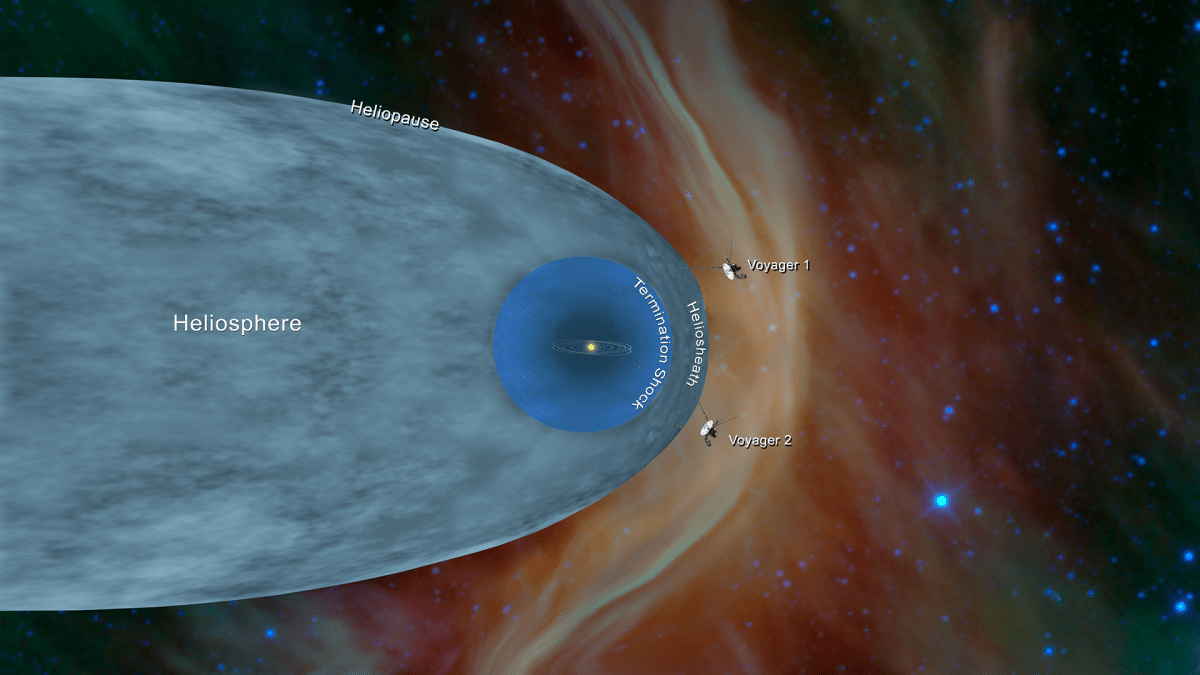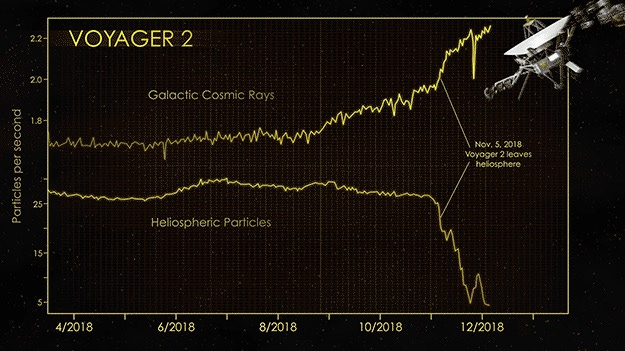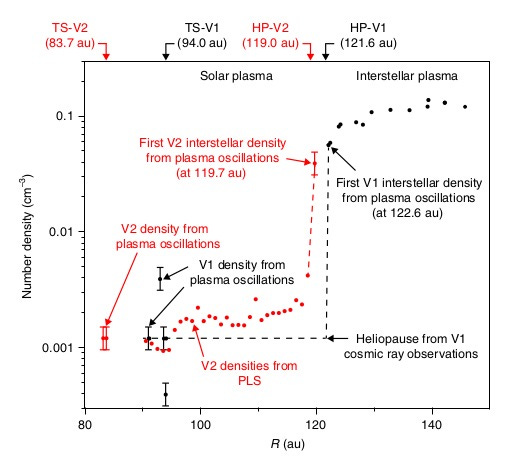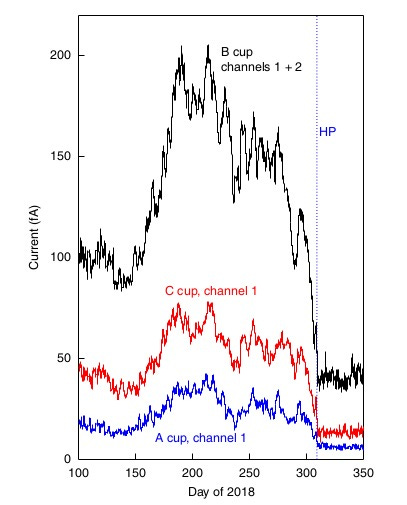First results from Voyagers, the NASA spacecraft at the edge of interstellar space
The twin Voyagers' observations have given us our first glimpse of what the space between stars is like.

Forty-two years ago, NASA launched the twin Voyager spacecraft on a path that would have them journey into interstellar space.
Today, both Voyager 1 and 2 are somewhere near the outer edge of the Solar System, transmitting valuable information about what their environment is like to scientists on Earth.
In 2012, these scientists used data from Voyager 1’s instruments to confirm that it had entered interstellar space on August 25 that year. Voyager 2 appeared to have achieved the same feat on November 5, 2018. This means both Voyagers have crossed the heliopause, the boundary until which the Sun’s magnetic field extends. The heliopause encompasses all the planets and a part of the Kuiper Belt, where Pluto resides.
Now, after further analysis, scientists have made some intriguing discoveries about the heliopause.
The Sun’s reach
The Sun constantly emits a stream of highly energetic charged particles, like electrons, protons, alpha particles, etc.—collectively called the solar wind. The solar wind flows along the Sun’s magnetic field through the Solar System.
Just like Earth’s magnetic field protects us from radiation from outer space, the Sun’s magnetic field protects us from cosmic radiation from interstellar space. Cosmic radiation particles are hundreds of times more energetic than the particles in the solar wind. The Sun’s magnetic field forms a protective bubble that blocks most of this cosmic radiation.
The outermost edge of this protective bubble is called the heliopause, the boundary where the Sun’s magnetic field and the interstellar/galactic magnetic field meet. Thus, the heliopause also separates the hot solar plasma from the relatively cooler interstellar plasma.

As Voyager 1 and 2 flew through space, they transmitted data that indicated to scientists the precise location of the heliopause. Voyager 1 found the heliopause at 122 AU and Voyager 2, at 119 AU, 1 AU being the average distance between the Sun and Earth i.e ~150 million km. The heliopause is thus located at about thrice the average Sun-Pluto distance.
The heliopause doesn’t encompass the entire Solar System, however. The average orbits of many dwarf planets and small bodies in the Kuiper Belt takes them beyond the heliopause. Even after the Kuiper Belt lies the Oort cloud, which is where most comets that visit the Sun come from.
Since the Kuiper Belt is part of the Solar System, the Voyagers haven’t left the Solar System yet. However, they have certainly entered interstellar space, where the particles in space have different energy, distribution, velocity, etc., relative to within the heliopause.
The newly reported discoveries (published here, see references) are about this region of space.

Voyager 1 and 2 entered interstellar space in different trajectories. Voyager 1 moves north of the plane in which the planets orbit the Sun, while Voyager 2 moves south of it. As such, the instruments on both spacecraft experienced different parts of the heliopause and interstellar space at different times.
A magnetic barrier
Scientists tracked how the strength of the magnetic field in the probes’ surroundings changed before and after the Voyagers passed the heliopause using a magnetometer onboard. They found that the galactic magnetic field is much stronger than the solar one.
But the field strength didn’t increase abruptly. Just before closing in on the heliopause, Voyager 2 measured a 3x increase in the solar magnetic field’s strength. After crossing the heliopause, the local magnetic field strengthened further as the galactic magnetic field revealed itself.

Scientists found that the magnetic transition region to the heliopause spanned 0.7 AU (Sun-Venus distance), confirming older predictions (this and this) that such a magnetic barrier exists. It’s the result of interactions between the solar and galactic magnetic fields at the heliopause.
However, scientists found no such magnetic barrier in the Voyager 1 data, whose interstellar transition was smoother. But it did experience a wider heliopause than Voyager 2 and measured a weaker galactic magnetic field.
So scientists now have reason to believe the heliopause is non-uniform.
Energetic charged particles
The Voyagers also recorded changes in the amount of charged particles as they approached interstellar space. As both craft crossed the heliopause, there was a sharp decline in the number of charged particles from the solar wind. At the same time, the amount of cosmic radiation increased sharply, by 20% and 30% according to Voyager 1 and 2, respectively.

Again, the change wasn’t abrupt. Voyager 2 indicated that a significant fraction of the solar wind’s particles ‘leaked’ into interstellar space. They were being carried out along the magnetic field lines. After about half the Sun-Earth distance, the amount of charged particles decreased and then steadied. Scientists are now puzzled as to why Voyager 1’s instruments couldn’t observe such as gradual outward decline, instead noting one steep drop.

More strikingly, before Voyager 1 crossed the heliopause, scientists found two ‘pocket’ regions in the Sun’s bubble where the galactic magnetic field had moved in, bringing energetic cosmic radiation with it. Voyager 2 saw no such thing.

So while Voyager 2 saw a single but layered heliopause, Voyager 1 saw a non-uniform structure.
These measurements nicely complement the magnetic field measurements, and reinforce the idea that the heliopause is constantly changing under the influence of complex interactions with the Milky Way’s magnetic field. This isn’t different from how the solar wind constantly shapes Earth’s magnetic field.
Electron density
Scientists used the Plasma Wave Subsystem (PWS) onboard the Voyagers to measure the density of electrons in the plasma before and after crossing the heliopause. Both units found the electron density to be low before the heliopause and 60x higher after.
Scientists had anticipated this increase but were surprised to find the transition to the higher density wasn’t sharp. They found a region between the heliopause and interstellar space that hosts intermediate electron densities. This transition region extended for a rather large 10 AU—the Sun-Saturn distance.

In fact, scientists had seen signs of just such a transition layer 25 years ago, when both Voyagers remotely studied the interstellar plasma beyond the heliopause. With direct measurements in hand, scientists are now sure that there is a large transition region between the heliopause and interstellar space.
Hot interstellar plasma
Unlike all other observations, only Voyager 2 undertook direct plasma measurements. The main plasma instrument on Voyager 1 had failed in 1980, three years after launch, forcing it to rely on indirect measurements from the PWS instrument.
Voyager 2 saw that at 1.5 AU (Sun-Mars distance) before the heliopause, the plasma density doubled and the temperature climbed. This sharply contrasts Voyager 1’s indirect measurement, in which the plasma density decreased gradually for about 6 AU until the heliopause arrived.

Scientists were also surprised to find that interstellar space is much hotter than expected. Voyager 2 recorded temperatures ranging between 30,000° Celsius and 50,000° Celsius. Scientific models had suggested a relatively cooler environment of 15,000° to 30,000° Celsius.
Scientists think the interaction between the two magnetic fields—solar and galactic—compressed the surrounding plasma and heated it. This could also explain the higher plasma temperature Voyager 2 measured just before the heliopause.
Conclusion
Armed with Voyager data, scientists now know that the heliopause changes in shape and size at different times and places, as the solar and galactic magnetic fields dance around each other.
The Voyagers are expected to stay in touch with Earth until around 2025, after which the small nuclear generators onboard will start to wane. By then, scientists hope to accurately characterize the properties of interstellar space.
New Horizons, the first spacecraft to visit Pluto and a Kuiper Belt object (Ultima Thule), will cross the heliopause sometime after 2038. If its nuclear power source doesn’t run out by then, it could help improve what we know about the gateway to interstellar space. Space agencies haven’t planned for any other interstellar missions in the near future.
Indeed, the Voyagers probes were part of a NASA experiment that continue to be productive four decades after launch. The world has acquired an entire generation of scientists in this time.
Studying how solar and galactic magnetic fields interact is useful to understand how stars influence their surroundings.
The Voyagers’ observations have given us our first glimpse of what the outermost part of the protective bubble formed by our Sun’s magnetic field is like, and of the interstellar space that lies beyond. This is the beginning of the human project to map and characterize our largely uncharted interstellar neighborhood, and lay the first cornerstone for future interstellar missions.
Originally published at The Wire.
Like what you read? Support me to keep me going.
